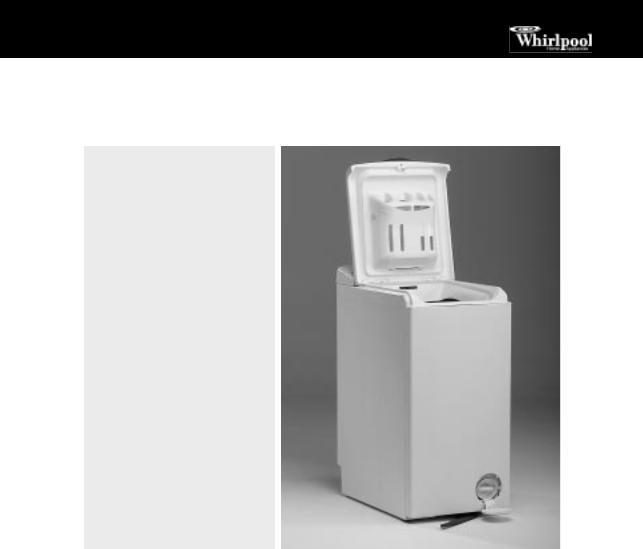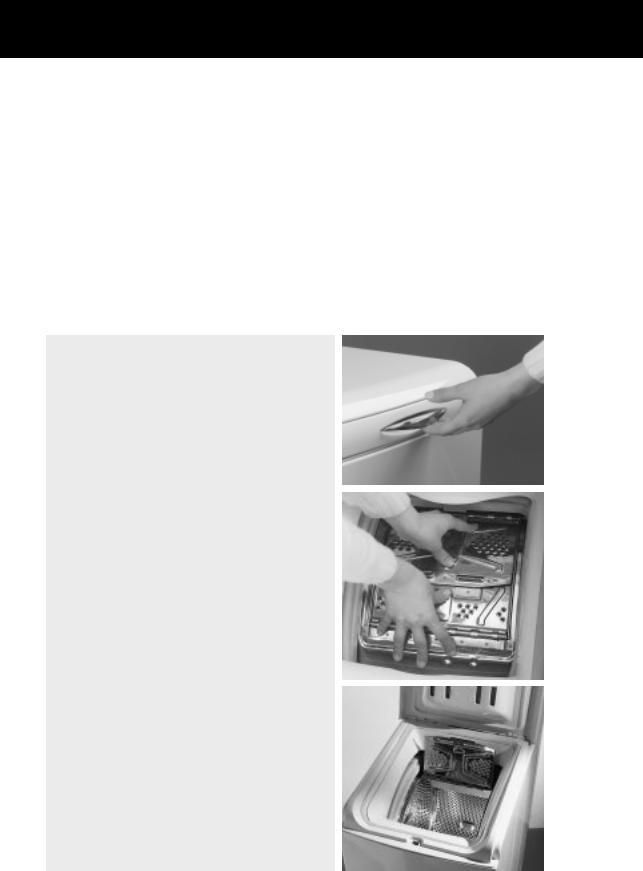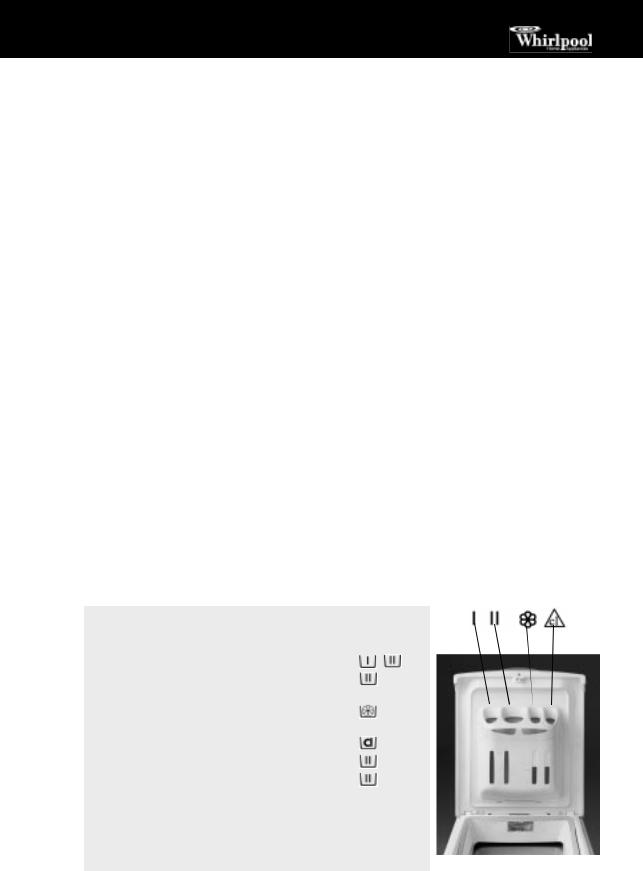Whirlpool AWA 6106, TA 153, TW 153, TA 152, AWA 6125 User Manual
...
CONTENTS
BEFORE USING THE WASHING MACHINE FIRST WASH CYCLE
PRECAUTIONS AND GENERAL RECOMMENDATIONS DESCRIPTION OF THE WASHING MACHINE PREPARATION OF THE WASHING
DETERGENTS AND ADDITIVES
PROGRAMME SELECTION
CLEANING THE FOREIGN BODY TRAP
DRAINING RESIDUAL WATER
CARE AND MAINTENANCE
TROUBLESHOOTING GUIDE
AFTER-SALES SERVICE
TRANSPORT AND HANDLING
INSTALLATION

BEFORE USING THE WASHING MACHINE
1.Remove the packaging and check
a.Cut and remove the shrink-wrap.
b.Remove the top protection and the protective corners.
c.Remove the bottom protection by tilting and turning the washing machine on one rear bottom corner.
d.Open the lid by pressing it slightly down while raising the handle. Remove the polystyrene cushion.
e.Remove the blue protective film from the panel (depending on model).
•After unpacking, make sure that the washing machine is undamaged. If in doubt, do not use the washing machine. Contact After-Sales Service or your local retailer.
•Keep the packaging materials (plastic bags, polystyrene parts, etc.) out of reach of children; they are potentially dangerous.
2.Remove the transport bracket
•The washing machine is fitted with transport screws and a transport bracket to prevent damage during transport. Before using the washing machine you must remove the transport bracket (see “Installation/Remove the transport bracket”).
3.Install the washing machine
•Place the washing machine on a flat and stable floor surface.
•Adjust the feet to ensure that the machine is stable and level (see “Installation/Adjust the feet”).
4.Water supply
•Connect the water supply inlet hose in accordance with the regulations of your local water company (see “Installation/Connect the water inlet hose”).
•Water supply: Cold water only
• |
Tap: |
3/4” threaded hose connection |
• |
Pressure: |
100-1000 kPa (1-10 bar). |
5.Drain hose
•Connect the drain hose to the siphon or hook it over the edge of a sink with the “U” bend (see “Installation/Connect the water drain hose”).
•If the washing machine is connected to a builtin drainage system, ensure the latter is equipped with a vent to avoid simultaneous loading and draining of water (siphoning effect).
6.Electrical connection
•Electrical connections must be carried out by a qualified technician in compliance with the manufacturer’s instructions and the current standard safety regulations.
•The technical data (voltage, power and fuses) are given on the rating plate on the rear of the washing machine.
•The washing machine must be connected exclusively by means of a socket with an earth connection in accordance with current regulations. The washing machine must be earthed by law. The manufacturer declines all liability for damage to persons or property deriving directly or indirectly from failure to observe the directions.
•Do not use extension leads or multi sockets.
•Before any maintenance on the washing machine disconnect it from the mains supply.
•Access to the mains plug or to disconnection from the mains supply via a double-pole switch must be ensured at all times following the installation.
•Do not operate the washing machine if it has been damaged during transport. Inform the After-Sales Service.
•Mains cable replacement is only to be carried out by After-Sales Service.
•The washing machine must be connected to an effective earthing installation, in compliance with the regulations in force. In particular, washing machines installed in premises containing a shower or a bath must be protected by a differential residual current device of at least 30 mA. Earthing the washing machine is obligatory under the law. The manufacturer declines all liability for damage to persons or property deriving either directly or indirectly from failure to observe the directions above.
•The washing machine may only be used in the household for the prescribed uses.
Dimensions: |
|
Width: |
400 mm |
Height: |
900 mm |
Depth: |
600 mm |
19

FIRST WASH CYCLE
We recommend that the first wash cycle be carried out empty. This will remove any residual water used in the factory checks.
1.Turn on the tap.
2.Close the drum flaps.
3.Pour a small amount of detergent (about 30 ml) into the detergent dispenser  .
.
4.Press the “On/Off” button.
5.Select a short programme (see programme chart).
6.Press the “Start” button.
PRECAUTIONS AND GENERAL RECOMMENDATIONS
1.Packing
•The packaging materials are 100% recyclable and
bear the recycling symbol  . Adhere to local regulations when disposing of packaging material.
. Adhere to local regulations when disposing of packaging material.
2.Energy saving tips
•Achieve the best use of energy, water, detergent and time by using the recommended maximum load size.
•Do not exceed the detergent dosages indicated in the manufacturer’s instructions.
•The Eco Ball - a special system in the outlet - will prevent detergent loss from the drum to avoid detergent loss into the environment.
•Use “Prewash” for heavily soiled laundry only! Save detergent, time, water and energy consumption by not selecting “Prewash” for slight to normally soiled laundry.
•Pretreat stains with stain remover or soak dried in stains in water before washing to reduce the necessity of a hot wash program.
•Save energy by using a 60° C instead of a 90° C wash programme or a 40° C instead of a 60° C wash programme.
•Save energy and time by selecting a high spin speed to reduce the water content in laundry before using a tumble dryer (for machines with adjustable spin speed).
3.Disposing of packaging and old washing machines
•The washing machine is built from reusable materials. The washing machine must be disposed of in compliance with current local waste disposal regulations.
•Before scrapping, cut of the power cable so that the washing machine cannot be connected to the mains.
•Remove detergent from compartment if you intend scrapping your washing machine.
4.Child safety
•Children must not be allowed to play with or in the washing machine.
5.General recommendations
•Do not leave the washing machine connected when not in use. Turn off the tap.
•Before cleaning or carrying out maintenance switch off the washing machine and disconnect it from the mains supply.
•To clean the outside of the washing machine, use a neutral detergent and a damp cloth.
•Do not use abrasive detergents.
•Do not attempt to force the lid open.
•If necessary, the power cable may be replaced with an identical one obtained from our AfterSales Service. The power cable must only be replaced by a qualified technician.
6.EC Declaration of Conformity
•This washing machine has been designed, constructed and distributed in compliance with the safety requirements of EC Directives: 73/23/EEC Low Voltage Directive
89/336/EEC EMC Directive 93/68/EEC CE Marking Directive 

20

DESCRIPTION OF THE WASHING MACHINE
1.Lid
2.Detergent dispenser
3.Drum flaps
•To open the drum press the small flap and hold the large flap.
4.Pump and foreign body trap
5.After-Sales Service sticker (behind the foreign body trap cover)
6.Mobility lever (depending on model)
•To move the washing machine: pull the handle out a little bit by hand and pull it out to the stop with the foot.
7.Adjustable feet
PREPARATION OF THE WASHING
Sort the laundry
1. Sort the laundry according to…
•Type of fabric / care label symbol
Cottons, mixed fibres, easy care/synthetics, wool, handwashed items.
•Colour
Separate whites and coloureds. Wash new coloured items separately.
•Size
Wash items of different sizes in the same load to improve efficiency and distribution in the drum.
•Fabric delicacy
Wash delicate articles separately: use a special
programme for Pure New Wool  , curtains and other delicates. Always remove curtain glides or wash curtains with the glides inside a cotton bag. Use the special program for handwash fabrics. Wash
, curtains and other delicates. Always remove curtain glides or wash curtains with the glides inside a cotton bag. Use the special program for handwash fabrics. Wash
stockings, belts and other small items or articles with hooks (e.g. bras) in special cotton bags for washing machines or in zipped pillow cases.
2.Empty pockets
Coins, safety pins and similar items can damage your washing machine drum and tub.
3.Fasteners
Close zips and fasten buttons or hooks; loose belts or ribbons should be tied together.
21

Stain removal
•Blood, milk, egg and other organic substances are generally removed by the enzyme phase of the programme.
•To remove red wine, coffee, tea, grass and fruit
stains etc. add a stain removing agent in detergents dispenser compartment  or chlorine bleach in compartment
or chlorine bleach in compartment  (depending on model).
(depending on model).
•Particularly stubborn stains should be treated before the wash.
Dyeing and bleaching
Products usually consist of dye colour, fixing agent and salt. Pour the dye colour, the fixing agent and then the salt directly into the empty drum. Load the laundry only afterwards.
•Only use dyes and bleaches recommended for washing machines.
•Follow the manufacturer’s instructions.
•Plastic and rubber parts of the machine may be stained by dyes or bleaches.
Starching
• Dissolve/dilute the starch, powder or liquid, in approximately 1 litre water outside of the washing machine in a small container. Load the washing machine, close the drum flaps and pour the dissolved starch directly on the drum. Then close the lid, select the programme “Rinse and Spin” and start.
Loading the laundry
1.Open the machine lid.
2.Open the drum by pressing the small flap and holding the large flap.
3.Place the items of laundry in the drum one by one
without compressing them. Follow loads |
|
recommended in the “programme chart”: overloading |
1 |
will result in unsatisfactory washing results and |
|
creased laundry. |
|
4. Close the drum flaps and check that they are properly locked.
2
3
22

DETERGENTS AND ADDITIVES
Choice of the right detergents and additives
The type of detergent depends on:
•type of fabric (cottons, easy care/synthetics, delicate items, wool).
Note: use only specific detergents for wool.
•colour;
•washing temperature;
•degree and type of soiling.
Notes:
Whitish residues on dark fabrics are caused by insoluble detergents components used in modern phosphate-free powder detergents. If you notice this problem, shake or brush the affected items or use a liquid detergents.
Keep detergents and additives in a dry place and out of reach of children.
Use only detergents and additives specifically produced for domestic washing machines.
If you use descaling agents, dyes or bleaches, make sure they are suitable for washing machine use. Descaler could contain components that can attack parts of your washing machine.
Do not use solvents (turpentine, benzine, etc.). Do not machine wash fabrics that have been treated with solvents or flammable liquids.
Dosage
Follow the instructions on the detergent pack in relation to:
•the degree and type of soiling;
•the size of the load;
-full load: follow the detergent manufacturer’s instructions;
-half load: 3/4 the amount used for a full load;
-minimum load (about 1 kg): half the amount used for a full load;
•water hardness in your area (ask for information from your water company): soft water requires
less detergent than hard water.
Notes:
Too much detergent can result in excess foam formation, and the reduction of washing efficiency. If the washing machine detects excessive foam it may prevent spinning.
Insufficient detergent may result in:
grey laundry, deposits on the drum, tub and heater. When using concentrated fabric softeners, add water in the detergents dispenser up to “MAX” level mark.
To prevent dispensing problems when using highly concentrated powder and liquid detergents, use the special detergent ball or bag supplied with the detergent and place it inside the drum.
WATER HARDNESS CHART
WATER HARDNESS |
CHARACTERISTICS |
GERMAN |
FRENCH |
ENGLISH |
CATEGORY |
|
°dH |
°fH |
°eH |
1 |
soft |
0-7 |
0-12 |
0-9 |
2 |
medium |
7-14 |
12-25 |
9-17 |
3 |
hard |
14-21 |
25-37 |
17-26 |
4 |
very hard |
over 21 |
over 37 |
over 26 |
Filling up with detergents and additives
The dispenser will have three or four compartments depending on model. Pour in the detergent:
• Washing powder for prewash and main wash
• Washing powder for main wash without prewash
• Fabric softeners and starch products, no more than to “MAX” mark.
• Chlorine bleach, no more than to “MAX” mark. (only four compartments model)
• Stain removers
• Water softeners (water hardness class 4)
• Starch (dissolved in water)  Be careful not to fill more than the “MAX” level mark.
Be careful not to fill more than the “MAX” level mark.
Do not use liquid detergents for programmes with prewash.
For programmes without prewash and temperatures from cold to 40° C, it is recommended to use liquid detergents to avoid whitish residues on the laundry.
23
